- A Brief Intro To C++ & Its History
- The Detailed History & Timeline Of C++ (With Infographic)
- Importance Of C++
- Versions Of C++ Language
- Structure Of A C++ Program
- Comparison With Other Popular Programming Languages
- Conclusion
- Frequently Asked Questions
- Test Your Skills: Quiz Time
- What Are Variables In C++?
- Declaration & Definition Of Variables In C++
- Variable Initialization In C++
- Rules & Regulations For Naming Variables In C++ Language
- Different Types Of Variables In C++
- Different Types of Variable Initialization In C++
- Conclusion
- Frequently Asked Questions
- Test Your Skills: Quiz Time
- What Are Primitive Data Types In C++?
- Derived Data Types In C++
- User-Defined Data Types In C++
- Abstract Data Types In C++
- Data Type Modifiers In C++
- Declaring Variables With Auto Keyword
- Conclusion
- Frequently Asked Questions
- Test Your Skills: Quiz Time
- Structure Of C++ Program: Components
- Segment 1: Documentation Section Of Structure Of C++ Program (With Example)
- Segment 2: Preprocessing & Namespace (Linking) Section Of CPP Program
- Segment 3: Definition Section In Structure of a C++ Program (With Examples)
- Segment 4: Main Function In Structure Of A C++ Program (With Example)
- Compilation & Execution Of C++ Programs | Step-by-Step Explanation
- Explaining Structure Of C++ Program With Suitable Example
- Conclusion
- Frequently Asked Questions
- Test Your Skills: Quiz Time
- What is Typedef in C++?
- The Role & Applications of Typedef in C++
- Basic Syntax for typedef in C++
- How Does typedef Work in C++?
- How to Use Typedef in C++ With Examples? (Multiple Data Types)
- The Difference Between #define & Typedef in C++
- Conclusion
- Frequently Asked Questions
- Test Your Skills: Quiz Time
- What Are Strings In C++?
- Types Of Strings In C++
- How To Declare & Initialize C-Style Strings In C++ Programs?
- How To Declare & Initialize Strings In C++ Using String Keyword?
- List Of String Functions In C++
- Operations On Strings Using String Functions In C++
- Concatenation Of Strings In C++
- How To Convert Int To Strings In C++
- Conclusion
- Frequently Asked Questions
- Test Your Skills: Quiz Time
- What Is String Concatenation In C++?
- How To Concatenate Two Strings In C++ Using The ‘+' Operator?
- String Concatenation Using The strcat( ) Function
- Concatenation Of Two Strings In C++ Using Loops
- String Concatenation Using The append() Function
- C++ String Concatenation Using The Inheritance Of Class
- Concatenate Two Strings In C++ With The Friend and strcat() Functions
- Why Do We Need To Concatenate Two Strings?
- How To Reverse Concatenation Of Strings In C++?
- Conclusion
- Frequently Asked Questions
- Test Your Skills: Quiz Time
- What Is Find In String C++?
- What Is A Substring?
- How To Find A Substring In A String In C++?
- How To Find A Character In String C++?
- Find All Substrings From A Given String In C++
- Index Substring In String In C++ From A Specific Start To A Specific Length
- Conclusion
- Frequently Asked Questions
- Test Your Skills: Quiz Time
- What Are Pointers In C++?
- Pointer Declaration In C++
- How To Initialize And Use Pointers In C++?
- Different Types Of Pointers In C++
- References & Pointers In C++
- Arrays And Pointers In C++
- String Literals & Pointers In C++
- Pointers To Pointers In C++ (Double Pointers)
- Arithmetic Operation On Pointers In C++
- Advantages Of Pointers In C++
- Some Common Mistakes To Avoid With Pointers In Cpp
- Conclusion
- Frequently Asked Questions
- Test Your Skills: Quiz Time
- Understanding Pointers In C++
- What Is Pointer To Object In C++?
- Declaration And Use Of Object Pointers In C++
- Advantages Of Pointer To Object In C++
- Pointer To Objects In C++ With Arrow Operator
- An Array Of Objects Using Pointers In C++
- Base Class Pointer For Derived Class Object In C++
- Conclusion
- Frequently Asked Questions
- Test Your Skills: Quiz Time
- What Is 'This' Pointer In C++?
- Defining ‘this’ Pointer In C++
- Example Of 'this' Pointer In C++
- Describing The Constness Of 'this' Pointer In C++
- Important Uses Of 'this' Pointer In C++
- Method Chaining Using 'this' Pointer In C++
- C++ Programs To Show Application Of 'This' Pointer
- How To Delete The ‘this’ Pointer In C++?
- Conclusion
- Frequently Asked Questions
- Test Your Skills: Quiz Time
- What is Reference?
- What is Pointer?
- Comparison Table Of C++ Pointer Vs. Reference
- Differences Between Reference And Pointer: A Detailed Explanation
- Why Are References Less Powerful Than Pointers?
- Conclusion
- Frequently Asked Questions
- Test Your Skills: Quiz Time
- How To Declare A 2D Array In C++?
- C++ Multi-Dimensional Arrays
- Ways To Initialize A 2D Array In C++
- Methods To Dynamically Allocate A 2D Array In C++
- Accessing/ Referencing Two-Dimensional Array Elements
- How To Initialize A Two-Dimensional Integer Array In C++?
- How To Initialize A Two-Dimensional Character Array?
- How To Enter Data In Two-Dimensional Array In C++?
- Conclusion
- Frequently Asked Questions
- What Are Arrays Of Strings In C++?
- Different Ways To Create String Arrays In C++
- How To Access The Elements Of A String Array In C++?
- How To Convert Char Array To String?
- Conclusion
- Frequently Asked Questions
- What is Memory Allocation in C++ & Why Do We Need It?
- How Does Dynamic Memory Allocation Work?
- The new Operator in C++
- The delete Operator in C++
- Dynamic Memory Allocation in C++ | Arrays
- Did You Know: Companies That Ask About Dynamic Memory Allocation
- Dynamic Memory Allocation in C++ | Objects
- Deallocation of Dynamic Memory in C++
- malloc(), calloc(), and free() Functions in C/C++
- Applications of Dynamic Memory Allocation in C++
- Conclusion
- Frequently Asked Questions
- Test Your Skills: Quiz Time
- What Is A Substring In C++ (Substr C++)?
- Example for substr() in C++ | Finding Substring Using Positive and Negative Indices
- Understanding substr() Basics with Examples
- Use Cases/ Examples of substr() in C++
- How to Get a Substring Before a Character Using substr() in C++?
- Use substr() in C++ to Print all Substrings of a Given String
- Print Sum of all Substrings of a String Representing a Number
- Minimum Value of all Substrings of a String Representing a Number
- Maximum Value of all Substrings of a String Representing a Number
- Points To Remember For Substr In C++
- Conclusion
- Frequently Asked Questions
- Test Your Skills: Quiz Time
- What Is Operator In C++?
- Types Of Operators In C++ With Examples
- What Are Arithmetic Operators In C++?
- What Are Assignment Operators In C++?
- What Are Relational Operators In C++?
- What Are Logical Operators In C++?
- What Are Bitwise Operators In C++?
- What Is Ternary/ Conditional Operator In C++?
- Miscellaneous Operators In C++
- Precedence & Associativity Of Operators In C++
- Conclusion
- Frequently Asked Questions
- Test Your Skills: Quiz Time
- What Is The New Operator In C++?
- Example To Understand New Operator In C++
- The Grammar Elements Of The New Operator In C++
- Storage Space Allocation
- How Does The C++ New Operator Works?
- What Happens When Enough Memory In The Program Is Not Available?
- Initializing Objects Allocated With New Operator In C++
- Lifetime Of Objects Allocated With The New Operator In C++
- What Is The Delete Operator In C++?
- Difference Between New And Delete Operator In C++
- Conclusion
- Frequently Asked Questions
- Test Your Skills: Quiz Time
- Types Of Overloading In C++
- What Is Operator Overloading In C++?
- How To Overload An Operator In C++?
- Overloadable & Non-overloadable Operators In C++
- Unary Operator Overloading In C++
- Binary Operator Overloading In C++
- Special Operator Overloading In C++
- Rules For Operator Overloading In C++
- Advantages And Disadvantages Of Operator Overloading In C++
- Function Overloading In C++
- What Is the Difference Between Operator Functions and Normal Functions?
- Conclusion
- Frequently Asked Questions
- Test Your Skills: Quiz Time
- What Are Operators In C++?
- Introduction To Logical Operators In C++
- Types Of Logical Operators In C++ With Example Program
- Logical AND (&&) Operator In C++
- Logical NOT(!) Operator In C++
- Logical Operator Precedence And Associativity In C++
- Relation Between Conditional Statements And Logical Operators In C++
- C++ Relational Operators
- Conclusion
- Frequently Asked Important Interview Questions:
- Test Your Skills: Quiz Time
- Different Type Of C++ Bitwise Operators
- C++ Bitwise AND Operator
- C++ Bitwise OR Operator
- C++ Bitwise XOR Operator
- Bitwise Left Shift Operator In C++
- Bitwise Right Shift Operator In C++
- Bitwise NOT Operator
- What Is The Meaning Of Set Bit In C++?
- What Does Clear Bit Mean?
- Conclusion
- Frequently Asked Questions
- Test Your Skills: Quiz Time
- Types of Comments in C++
- Single Line Comment In C++
- Multi-Line Comment In C++
- How Do Compilers Process Comments In C++?
- C- Style Comments In C++
- How To Use Comment In C++ For Debugging Purposes?
- When To Use Comments While Writing Codes?
- Why Do We Use Comments In Codes?
- Conclusion
- Frequently Asked Questions
- Test Your Skills: Quiz Time
- What Are Storage Classes In Cpp?
- What Is The Scope Of Variables?
- What Are Lifetime And Visibility Of Variables In C++?
- Types of Storage Classes in C++
- Automatic Storage Class In C++
- Register Storage Class In C++
- Static Storage Class In C++
- External Storage Class In C++
- Mutable Storage Class In C++
- Conclusion
- Frequently Asked Questions
- Test Your Skills: Quiz Time
- Decision Making Statements In C++
- Types Of Conditional Statements In C++
- If-Else Statement In C++
- If-Else-If Ladder Statement In C++
- Nested If Statements In C++
- Alternatives To Conditional If-Else In C++
- Switch Case Statement In C++
- Jump Statements & If-Else In C++
- Conclusion
- Frequently Asked Questions
- Test Your Skills: Quiz Time
- What Is A Switch Statement/ Switch Case In C++?
- Rules Of Switch Case In C++
- How Does Switch Case In C++ Work?
- The break Keyword In Switch Case C++
- The default Keyword In C++ Switch Case
- Switch Case Without Break And Default
- Advantages & Disadvantages of C++ Switch Case
- Conclusion
- Frequently Asked Questions
- Test Your Skills: Quiz Time
- What Is A For Loop In C++?
- Syntax Of For Loop In C++
- How Does A For Loop In C++ Work?
- Examples Of For Loop Program In C++
- Ranged Based For Loop In C++
- Nested For Loop In C++
- Infinite For Loop In C++
- Conclusion
- Frequently Asked Questions
- Test Your Skills: Quiz Time
- What Is A While Loop In C++?
- Parts Of The While Loop In C++
- C++ While Loop Program Example
- How Does A While Loop In C++ Work?
- What Is Pre-checking Process Or Entry-controlled Loop?
- When Are While Loops In C++ Useful?
- Example C++ While Loop Program
- What Are Nested While Loops In C++?
- Infinite While Loop In C++
- Alternatives To While Loop In C++
- Conclusion
- Frequently Asked Questions
- Test Your Skills: Quiz Time
- What Are Loops & Its Types In C++?
- What Is A Do-While Loop In C++?
- Do-While Loop Example In C++ To Print Numbers
- How Does A Do-While Loop In C++ Work?
- Various Components Of The Do-While Loop In C++
- Example 2: Adding User-Input Positive Numbers With Do-While Loop
- C++ Nested Do-While Loop
- C++ Infinitive Do-while Loop
- What is the Difference Between While Loop and Do While Loop in C++?
- When To Use A Do-While Loop?
- Conclusion
- Frequently Asked Questions
- Test Your Skills: Quiz Time
- What are 2D Vectors in C++?
- How to Declare 2D Vectors in C++
- How to Initialize a 2D Vector in C++?
- Creating a 2D Vector in C++ with User Input for Column & Row Size
- Methods for Traversing 2D Vectors in C++
- Interview Spotlight: 2D Vectors in FAANG Interviews
- Printing 2D Vector in C++ Using Nested Loops
- Example C++ Programs for Creating 2D Vectors
- How to Access & Modify 2D Vector Elements in C++?
- Adding Elements to 2D Vector Using push_back() Function
- Removing Elements from Vector in C++ Using pop_back() Function
- Did You Know? Real-World Outage: Crash Cause Linked to 2D Vector Usage
- Advantages of 2D Vectors Over Traditional Arrays
- Conclusion
- Frequently Asked Questions
- Test Your Skills: Quiz Time
- How To Print A Vector In C++ By Overloading Left Shift (<<) Operator?
- How To Print Vector In C++ Using Range-Based For-Loop?
- Print Vector In C++ With Comma Separator
- Printing Vector In C++ Using Indices (Square Brackets/ Double Brackets & at() Function)
- How To Print A Vector In C++ Using std::copy?
- How To Print A Vector In C++ Using for_each() Function?
- Printing C++ Vector Using The Lambda Function
- How To Print Vector In C++ Using Iterators?
- Conclusion
- Frequently Asked Questions
- Definition Of C++ Find In Vector
- Using The std::find() Function
- How Does find() In Vector C++ Function Work?
- Finding An Element By Custom Comparator Using std::find_if() Function
- Use std::find_if() With std::distance()
- Element Find In Vector C++ Using For Loop
- Using The find_if_not Function
- Find Elements With The Linear Search Approach
- Conclusion
- Frequently Asked Questions
- What Is Sort() Function In C++?
- Sort() Function In C++ From Standard Template Library
- Exceptions Of Sort() Function/ Algorithm In C++
- The Stable Sort() Function In C++
- Partial Sort() Function In C++
- Sorting In Ascending Order With Sort() Function In C++
- Sorting In Descending Order With Sort Function In C++
- Sorting In Desired Order With Custom Comparator Function & Sort Function In C++
- Sorting Elements In Desired Order Using Lambda Expression & Sort Function In C++
- Types of Sorting Algorithms In C++
- Advanced Sorting Algorithms In C++
- How Does the Sort() Function Algorithm Work In C++?
- Conclusion
- Frequently Asked Questions
- What Is Function Overloading In C++?
- Ways Of Function Overloading In C++
- Function Overloading In C++ Using Different Types Of Parameters
- Function Overloading In C++ With Different Number Of Parameters
- Function Overloading In C++ Using Different Sequence Of Parameters
- How Does Function Overloading In C++ Work?
- Rules Of Function Overloading In C++
- Why Is Function Overloading Used?
- Types Of Function Overloading Based On Time Of Resolution
- Causes Of Function Overloading In C++
- Ambiguity & Function Overloading In C++
- Advantages Of Function Overloading In C++
- Disadvantages Of Function Overloading In C++
- Operator Overloading In C++
- Function Overriding In C++
- Difference Between Function Overriding & Function Overloading In C++
- Conclusion
- Frequently Asked Questions
- What Is An Inline Function In C++?
- How To Define The Inline Function In C++?
- How Does Inline Function In C++ Work?
- The Need For An Inline Function In C++
- Can The Compiler Ignore/ Reject Inline Function In C++ Programs?
- Normal Function Vs. Inline Function In C++
- Classes & Inline Function In C++
- Understanding Inline, __inline, And __forceinline Functions In C++
- When To Use An Inline Function In C++?
- Advantages Of Inline Function In C++
- Disadvantages Of Inline Function In C++
- Why Not Use Macros Instead Of An Inline Function In C++?
- Conclusion
- Frequently Asked Questions
- Test Your Skills: Quiz Time
- What Is Static Data Member In C++?
- How To Declare Static Data Members In C++?
- How To Initialize/ Define Static Data Member In C++?
- Ways To Access A Static Data Member In C++
- What Are Static Member Functions In C++?
- Example Of Member Function & Static Data Member In C++
- Practical Applications Of Static Data Member In C++
- Conclusion
- Frequently Asked Questions
- What Is A Constant In C++?
- Ways To Define Constant In C++
- What Are Literals In C++?
- Pointer To A Constant In C++
- Constant Function Arguments In C++
- Constant Member Function Of Class In C++
- Constant Data Members In C++
- Object Constant In C++
- Conclusion
- Frequently Asked Questions(FAQ)
- What is the Friend Function in C++?
- Declaration of Friend Function in C++ with Example
- Characteristics of Friend Function in C++
- Types/ Ways to Implement Friend Function in C++
- Global Friend Function in C++ (Global Function as Friend Function )
- Member Function of Another Class as a Friend Function in C++
- Function Overloading Using Friend Function in C++
- Advantages & Disadvantages of Friend Function in C++
- Interview Spotlight: Friend Functions in Cognizant Interview
- What is a C++ Friend Class?
- A Function Friendly to Multiple Classes
- C++ Friend Class vs. Friend Function in C++
- Some Important Points About Friend Functions and Classes in C++
- Conclusion
- Frequently Asked Questions
- What Is Function Overriding In C++?
- The Working Mechanism Of Function Overriding In C++
- Real-Life Example Of Function Overriding In C++
- Accessing Overriding Function In C++
- Accessing Overridden Function In C++
- Function Call Binding With Class Objects | Function Overriding In C++
- Function Call Binding With Base Class Pointers | Function Overriding In C++
- Advantages Of Function Overriding In C++
- Variations In Function Overriding In C++
- Function Overloading In C++
- Function Overloading Vs Function Overriding In C++
- Conclusion
- Frequently Asked Questions
- Errors In C++
- What Is Exception Handling In C++?
- Exception Handling In C++ Program Example
- C++ Exception Handling: Basic Keywords
- The Need For C++ Exception Handling
- C++ Standard Exceptions
- C++ Exception Classes
- User-Defined Exceptions In C++
- Advantages & Disadvantages Of C++ Exception Handling
- Conclusion
- Frequently Asked Questions
- What Are Templates In C++ & How Do They Work?
- Types Of Templates In C++
- What Are Function Templates In C++?
- C++ Template Functions With Multiple Parameters
- C++ Template Function Overloading
- What Are Class Templates In C++?
- Defining A Class Member Outside C++ Template Class
- C++ Template Class With Multiple Parameters
- What Is C++ Template Specialization?
- How To Specify Default Arguments For Templates In C++?
- Advantages Of C++ Templates
- Disadvantages Of C++ Templates
- Difference Between Function Overloading And Templates In C++
- Conclusion
- Frequently Asked Questions
- Structure
- Structure Declaration
- Initialization of Structure
- Copying and Comparing Structures
- Array of Structures
- Nested Structures
- Pointer to a Structure
- Structure as Function Argument
- Self Referential Structures
- Class
- Object Declaration
- Accessing Class Members
- Similarities between Structure and Class
- Which One Should You Choose?
- Key Difference Between a Structure and Class
- Summing Up
- Test Your Skills: Quiz Time
- What Is A Class And Object In C++?
- What Is An Object In C++?
- How To Create A Class & Object In C++? With Example
- Interview Spotlight: Classes & Objects In Adobe & Pixar Interviews
- Access Modifiers & Class/ Object In C++
- Member Functions Of A Class In C++
- How To Access Data Members And Member Functions?
- Significance Of Class & Object In C++
- Did You Know? The Concept of Classes & Object Powers Major Apps
- What Are Constructors In C++ & Its Types?
- What Is A Destructor Of Class In C++?
- An Array Of Objects In C++
- Object In C++ As Function Arguments
- The this (->) Pointer & Classes In C++
- The Need For Semicolons At The End Of A Class In C++
- Conclusion
- Frequently Asked Questions
- What Are Static Members In C++?
- Static Member Functions in C++
- Ways To Call Static Member Function In C++
- Properties Of Static Member Function In C++
- Need Of Static Member Functions In C++
- Regular Member Function Vs. Static Member Function In C++
- Limitations Of Static Member Functions In C++
- Conclusion
- Frequently Asked Questions
- What Is Constructor In C++?
- Characteristics Of A Constructor In C++
- Types Of Constructors In C++
- Default Constructor In C++
- Parameterized Constructor In C++
- Copy Constructor In C++
- Dynamic Constructor In C++
- Benefits Of Using Constructor In C++
- How Does Constructor In C++ Differ From Normal Member Function?
- Constructor Overloading In C++
- Constructor For Array Of Objects In C++
- Constructor In C++ With Default Arguments
- Initializer List For Constructor In C++
- Dynamic Initialization Using Constructor In C++
- Conclusion
- Frequently Asked Questions
- What Is A Constructor In C++?
- What Is Constructor Overloading In C++?
- Dеclaration Of Constructor Ovеrloading In C++
- Condition For Constructor Overloading In C++
- How Constructor Ovеrloading In C++ Works?
- Examples Of Constructor Overloading In C++
- Lеgal & Illеgal Constructor Ovеrloading In C++
- Types Of Constructors In C++
- Characteristics Of Constructors In C++
- Advantage Of Constructor Overloading In C++
- Disadvantage Of Constructor Overloading In C++
- Conclusion
- Frеquеntly Askеd Quеstions
- What Is A Destructor In C++?
- Rules For Defining A Destructor In C++
- When Is A Destructor in C++ Called?
- Order Of Destruction In C++
- Default Destructor & User-Defined Destructor In C++
- Virtual Destructor In C++
- Pure Virtual Destructor In C++
- Key Properties Of Destructor In C++ You Must Know
- Explicit Destructor Calls In C++
- Destructor Overloading In C++
- Difference Between Normal Member Function & Destructor In C++
- Important Uses Of Destructor In C++
- Conclusion
- Frequently Asked Questions
- What Is A Constructor In C++?
- What Is A Destructor In C++?
- Difference Between Constructor And Destructor In C++
- Constructor In C++ | A Brief Explanation
- Destructor In C++ | A Brief Explanation
- Difference Between Constructor And Destructor In C++ Explained
- Order Of Calling Constructor And Destructor In C++ Classes
- Conclusion
- Frequently Asked Questions
- Test Your Skills: Quiz Time
- What Is Type Conversion In C++?
- What Is Type Casting In C++?
- Types Of Type Conversion In C++
- Implicit Type Conversion (Coercion) In C++
- Explicit Type Conversion (Casting) In C++
- Advantages Of Type Conversion In C++
- Disadvantages Of Type Conversion In C++
- Difference Between Type Casting & Type Conversion In C++
- Application Of Type Casting In C++
- Conclusion
- Frequently Asked Questions
- What Is A Copy Constructor In C++?
- Characteristics Of Copy Constructors In C++
- Types Of Copy Constructors In C++
- When Do We Call The Copy Constructor In C++?
- When Is A User-Defined Copy Constructor Needed In C++?
- Types Of Constructor Copies In C++
- Can We Make The Copy Constructor In C++ Private?
- Assignment Operator Vs Copy Constructor In C++
- Example Of Class Where A Copy Constructor Is Essential
- Uses Of Copy Constructors In C++
- Conclusion
- Frequently Asked Questions
- Why Do You Need Object-Oriented Programming (OOP) In C++?
- OOPs Concepts In C++ With Examples
- The Class OOPs Concept In C++
- The Object OOPs Concept In C++
- The Inheritance OOPs Concept In C++
- Polymorphism OOPs Concept In C++
- Abstraction OOPs Concept In C++
- Encapsulation OOPs Concept In C++
- Other Features Of OOPs In C++
- Benefits Of OOP In C++ Over Procedural-Oriented Programming
- Disadvantages Of OOPS Concept In C++
- Why Is C++ A Partial OOP Language?
- Conclusion
- Frequently Asked Questions
- Introduction To Abstraction In C++
- Types Of Abstraction In C++
- What Is Data Abstraction In C++?
- Understanding Data Abstraction In C++ Using Real Life Example
- Ways Of Achieving Data Abstraction In C++
- What Is An Abstract Class?
- Advantages Of Data Abstraction In C++
- Use Cases Of Data Abstraction In C++
- Encapsulation Vs. Abstraction In C++
- Conclusion
- Frequently Asked Questions
- What Is Encapsulation In C++?
- How Does Encapsulation Work In C++?
- Types Of Encapsulation In C++
- Why Do We Need Encapsulation In C++?
- Implementation Of Encapsulation In C++
- Access Specifiers & Encapsulation In C++
- Role Of Access Specifiers In Encapsulation In C++
- Member Functions & Encapsulation In C++
- Data Hiding & Encapsulation In C++
- Features Of Encapsulation In C++
- Advantages & Disadvantages Of Encapsulation In C++
- Difference Between Abstraction and Encapsulation In C++
- Conclusion
- Frequently Asked Questions
- What Is Inheritance In C++?
- What Are Child And Parent Classes?
- Syntax And Structure Of Inheritance In C++
- Implementing Inheritance In C++
- Importance Of Inheritance In C++
- Types Of Inheritance In C++
- Visibility Modes Of Inheritance In C++
- Access Modifiers & Inheritance In C++
- How To Make A Private Member Inheritable?
- Member Function Overriding In Inheritance In C++
- The Diamond Problem | Inheritance In C++ & Ambiguity
- Ways To Avoid Ambiguity Inheritance In C++
- Why & When To Use Inheritance In C++?
- Advantages Of Inheritance In C++
- The Disadvantages Of Inheritance In C++
- Conclusion
- Frequently Asked Questions
- What Is Hybrid Inheritance In C++?
- Importance Of Hybrid Inheritance In Object Oriented Programming
- Example Of Hybrid Inheritance In C++: Using Single and Multiple Inheritance
- Example Of Hybrid Inheritance In C++: Using Multilevel and Hierarchical Inheritance
- Real-World Applications Of Hybrid Inheritance In C++
- Conclusion
- Frequently Asked Questions
- What Is Multiple Inheritance In C++?
- Examples Of Multiple Inheritance In C++
- Ambiguity Problem In Multiple Inheritance In C++
- Ambiguity Resolution In Multiple Inheritance In C++
- The Diamond Problem In Multiple Inheritance In C++
- Visibility Modes In Multiple Inheritance In C++
- Advantages & Disadvantages Of Multiple Inheritance In C++
- Multiple Inheritance Vs. Multilevel Inheritance In C++
- Conclusion
- Frequently Asked Questions
- What Is Multilevel Inheritance In C++?
- Block Diagram For Multilevel Inheritance In C++
- Multilevel Inheritance In C++ Example
- Constructor & Multilevel Inheritance In C++
- Use Cases Of Multilevel Inheritance In C++
- Multiple Vs Multilevel Inheritance In C++
- Advantages & Disadvantages Of Multilevel Inheritance In C++
- Conclusion
- Frequently Asked Questions
- What Is Hierarchical Inheritance In C++?
- Example 1: Hierarchical Inheritance In C++
- Example 2: Hierarchical Inheritance In C++
- Impact of Visibility Modes In Hierarchical Inheritance In C++
- Advantages And Disadvantages Of Hierarchical Inheritance In C++
- Use Cases Of Hierarchical Inheritance In C++
- Conclusion
- Frequently Asked Questions
- What Are Access Specifiers In C++?
- Types Of Access Specifiers In C++
- Public Access Specifiers In C++
- Private Access Specifier In C++
- Protected Access Specifier In C++
- The Need For Access Specifiers In C++
- Combined Example For All Access Specifiers In C++
- Best Practices For Using Access Specifiers In C++
- Why Can't Private Members Be Accessed From Outside A Class?
- Conclusion
- Frequently Asked Questions
- What Is The Diamond Problem In C++?
- Example Of The Diamond Problem In C++
- Resolution Of The Diamond Problem In C++
- Virtual Inheritance To Resolve Diamond Problem In C++
- Scope Resolution Operator To Resolve Diamond Problem In C++
- Conclusion
- Frequently Asked Questions
Structure of C++ Program | A Simplified Explanation With Examples
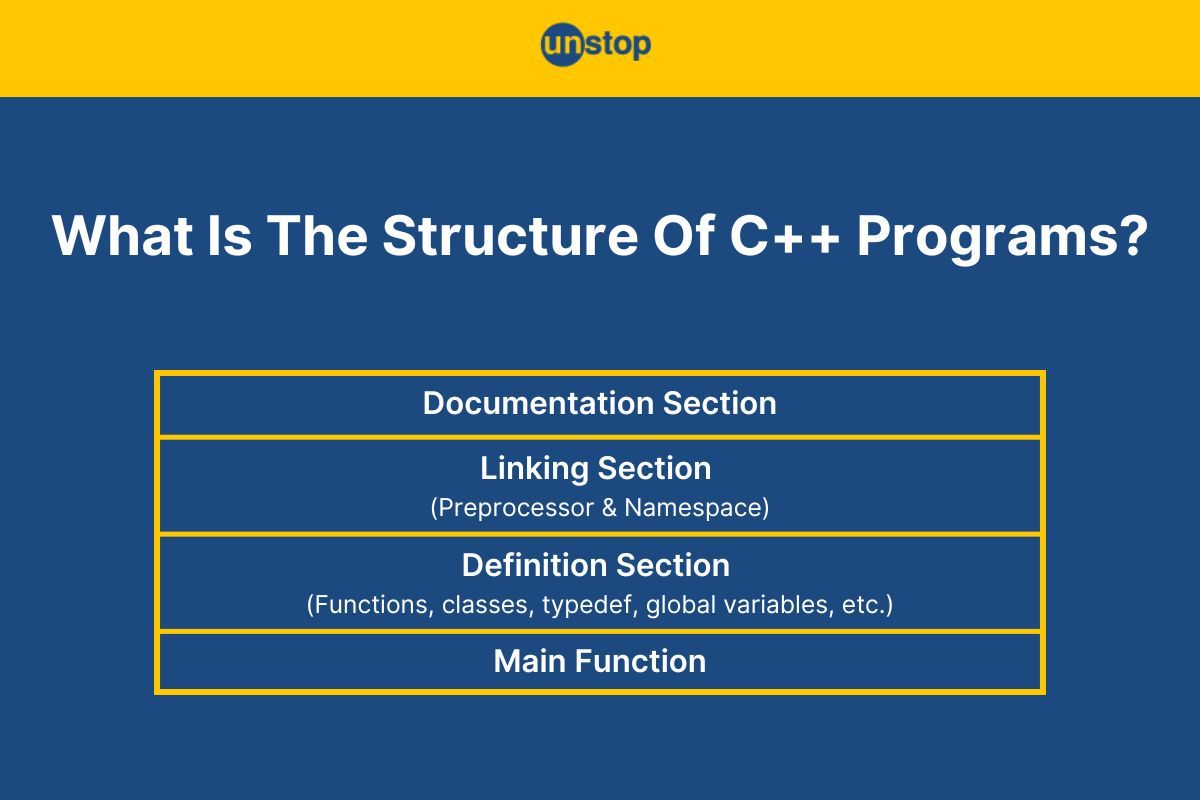
C++ is one of the most widely used programming languages in the world, known for its speed, flexibility, and ability to support both procedural and object-oriented programming paradigms. It powers a wide variety of applications–from games and operating systems to web browsers and embedded systems. To write and understand a C++ program effectively, it's important to be familiar with its fundamental building blocks.
In this blog, we’ll break down the basic structure of a C++ program, explain the key components of a C++ program and their roles, and guide you through how a program is compiled and executed.
Structure Of C++ Program: Components
A typical C++ program consists of one or more source code files (.cpp files), each contributing to the program’s logic. These files include various elements such as:
- Comments (for documentation)
- Header files (for including standard libraries or user-defined code)
- Namespaces (especially std, for avoiding naming conflicts)
- Global variables and constants
- Function prototypes
- Class and function definitions
- The main() function (the entry point of the program)
- Input/output statements (e.g., cin, cout)
The diagram below illustrates how these components are organized within a basic C++ program.
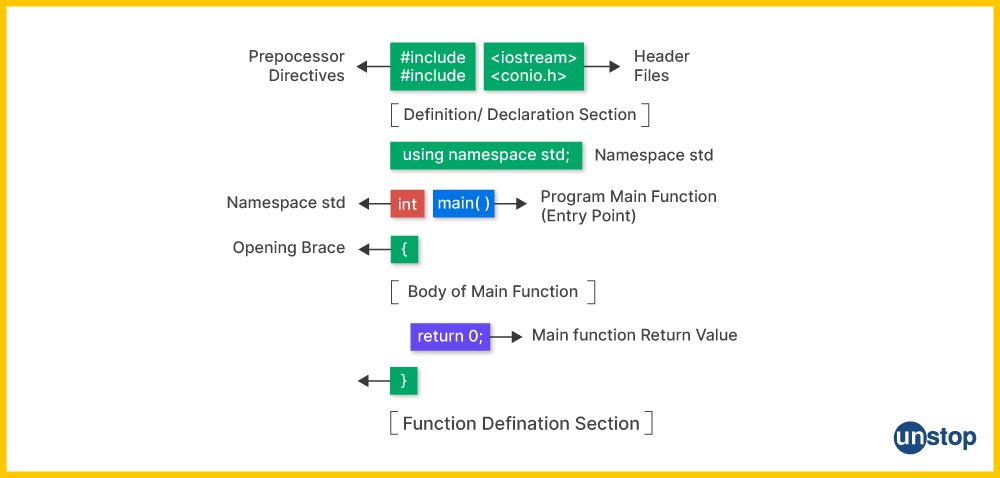
This example shows the whole program and its components, next we will see the main sections/segments that make the structure of any cpp program.
Explaining Core Segments Of A C++ Program
To simplify understanding, a C++ program can be conceptually divided into four main segments:
|
Documentation Segment (Optional but helpful) |
Includes comments that describe the purpose, author, or usage of the program. |
|
Preprocessing and Namespace Segment (Also referred to as Linking Segment) |
It includes:
|
|
Global and Declaration Segment |
This segment contains:
|
|
Main and Function Definition Segment |
This is the core part where:
|
We’ll explain the basic structure of C++ program (with examples) exploring each segment in detail in the sections below. By the end of this article, you’ll be able to clearly identify and implement the structural components of a C++ program–an essential step toward writing clean, maintainable, and efficient code.
Segment 1: Documentation Section Of Structure Of C++ Program (With Example)
The Documentation Section of a C++ program is crucial for providing context and clarity about the program's purpose/structure of the code, functionality, and usage.
Although the compiler ignores this section during compilation (which is why it is also optional), the section serves as an invaluable resource for developers or anyone reading or maintaining the code. It is highly recommended, especially in larger programs where understanding the intent behind the code is crucial.
Key elements typically included:
- Program Overview: A brief description of what the program does.
- Logic Explanation: An outline of the program's logic, including key algorithms or processes used.
- Author Information: Who wrote the code.
- Date of Creation: When it was created or last updated.
- Usage Instructions: Any specific instructions on how to compile and run the program.
- Program overview: What the program does.
- Logic summary: Core flow or key algorithm(s) used.
Example of a documentation section using multiline comments:
/* Program: This is a blog on the structure of C++ program
Author: Shivani Goyal
Description: Here, we will explain the different components of a C++ program with the help of example */
Segment 2: Preprocessing & Namespace (Linking) Section Of CPP Program
In C++, the initial part of a program typically includes directives and declarations that prepare the code for compilation. This segment comprises two main components:
- Preprocessor Directives
- Namespace Declarations
Collectively, these are sometimes informally referred to as the "linking section." However, it's important to note that, in standard C++ terminology, "linking" specifically pertains to the process where compiled object files are combined to form an executable. The inclusion of headers and namespace declarations occurs during the preprocessing and compilation phases, respectively, and not during the linking phase .
Preprocessor Directives In Structure Of C++ Program
Preprocessor directives are instructions that are processed before the actual compilation of code begins. Some examples of pe-processing tasks are:
- Including Header Files: To access standard or user-defined functions and classes.
- Defining Constants and Macros: To create symbolic names for values or code snippets. They allow values to be replaced by their names when macros are expanded.
Common Preprocessor Directives:
- #include: Includes the contents of a specified file. This is commonly used to incorporate standard or user-defined header files that contain function prototypes, class definitions, and other declarations essential for the program.
- #define: Defines macros or constants, allowing for symbolic names to represent values or code snippets.
- #ifdef, #ifndef, #endif: Conditional compilation directives that include or exclude parts of the code based on whether certain macros are defined.
Example:
#include <iostream> //importing header iostream to handle input/ output operations
#define PI 3.14159 //Defining a constant PI whose value is 3.14159
#define SQUARE(x) ((x) * (x)) // Defining a macro for calculating the square of a number
Here, we include the <iostream> header file, which provides access to the input/ output operations (such as cout and cin).
- Then we use the #define directive to define a constant named PI whose value cannot be changed across the program and a macro SQUARE which calculates the square of the argument x.
- We can access the constant by its name anywhere in the program. And for the macro, whenever we use the name SQUARE, the definition will be inserted inline.
- Note: Macros like SQUARE(x) should be used cautiously to avoid unexpected behaviors due to operator precedence.
Also read: Header Files In C | Standard & User Defined (Explained With Examples)
Namespace Declaration in Structure Of C++ Program
Namespaces in C++ are used to organize code into logical groups and prevent name collisions that can occur especially when your code base includes multiple libraries.
- In other words, namespace simply entails to the creation of named scopes used to organize and group related code.
- They are part of the C++ code processed during the compilation phase and help manage code across different parts of a program or across multiple libraries.
Standard Namespace:
The standard (std) namespace, encapsulated the Standard C++ library. Adding the line – using namespace std; – at the beginning of the program brings all standard library names into the global scope, allowing us to use cout instead of std::cout. The syntax of namespace is:
using namespace std;
Best Practices:
- Avoid using using namespace std; in header files to prevent namespace pollution.
- Prefer using specific declarations like using std::cout; when only a few components are needed.
Custom Namespaces:
In addition to the std namespace, you can also define your own namespaces to encapsulate your code. For example:
namespace MyNamespace {
void display() {
std::cout << "Hello from MyNamespace!" << std::endl;
}
}
Usage:
MyNamespace::display();
This approach helps in organizing code and avoiding naming conflicts in larger projects.
Segment 3: Definition Section In Structure of a C++ Program (With Examples)
The Definition Segment encompasses the declarations and definitions of global variables, constants, and functions. These elements are crucial for the program's functionality and are typically placed after the preprocessor directives and before the main() function.
What are Global Variables in Structure of C++ Programs?
Global variables are declared outside of all functions, classes, and blocks, making them accessible throughout the entire program. While they can be useful in certain scenarios, it's generally advisable to minimize their use to maintain code modularity and readability.
Best Practices for Global Variables:
- Minimize Usage: Overuse of global variables can lead to code that's difficult to debug and maintain, as they can introduce hidden dependencies and side effects.
- Use const or constexpr: If a global variable represents a value that shouldn't change, declare it as const or constexpr to prevent accidental modifications.
- Encapsulation: Group related global variables into a struct or class to encapsulate them, enhancing code organization.
- Naming Conventions: Use clear and consistent naming conventions, such as prefixing with g_ (e.g., g_configValue), to distinguish global variables from local ones.
Code Example:
#include
int g_counter = 0; // Global variable
void incrementCounter() {
g_counter++;
}
int main() {
incrementCounter();
std::cout << "Counter: " << g_counter << std::endl;
return 0;
}
I2luY2x1ZGUgPGlvc3RyZWFtPgppbnQgZ19jb3VudGVyID0gMDsgLy8gR2xvYmFsIHZhcmlhYmxlCnZvaWQgaW5jcmVtZW50Q291bnRlcigpIHsKICAgIGdfY291bnRlcisrOwp9CmludCBtYWluKCkgewogICAgaW5jcmVtZW50Q291bnRlcigpOwogICAgc3RkOjpjb3V0IDw8ICJDb3VudGVyOiAiIDw8IGdfY291bnRlciA8PCBzdGQ6OmVuZGw7CiAgICByZXR1cm4gMDsKfQ==
Output:
Counter: 1
In this example, g_counter is a global variable accessible both in incrementCounter() and main().
For more information on different types of variables, read: Variables In C++ | Declare, Initialize, Rules & Types (+Examples)
Function Declarations and Definitions in Structure of C++ Programs
Functions are blocks of code designed to perform specific tasks. They promote code reusability and modularity.
Function Declaration:
A function declaration (also known as a function prototype) informs the compiler about a function's name, return type, and parameters.
int add(int a, int b); // Function declaration
- In the structure of a C++ program, function declarations are made outside any other block, typically before the main() function.
- You can then use the function name with argument values to call the function.
Function Definition:
A function definition provides the actual body of the function. It can be placed alongside the declaration, after the main() function or in a separate source file.
int add(int a, int b) {
return a + b;
}
Code Example:
#include
// Function declaration
int multiply(int x, int y);
int main() {
int result = multiply(4, 5);
std::cout << "Product: " << result << std::endl;
return 0;
}
// Function definition
int multiply(int x, int y) {
return x * y;
}
I2luY2x1ZGUgPGlvc3RyZWFtPgovLyBGdW5jdGlvbiBkZWNsYXJhdGlvbgppbnQgbXVsdGlwbHkoaW50IHgsIGludCB5KTsKaW50IG1haW4oKSB7CiAgICBpbnQgcmVzdWx0ID0gbXVsdGlwbHkoNCwgNSk7CiAgICBzdGQ6OmNvdXQgPDwgIlByb2R1Y3Q6ICIgPDwgcmVzdWx0IDw8IHN0ZDo6ZW5kbDsKICAgIHJldHVybiAwOwp9Ci8vIEZ1bmN0aW9uIGRlZmluaXRpb24KaW50IG11bHRpcGx5KGludCB4LCBpbnQgeSkgewogICAgcmV0dXJuIHggKiB5Owp9
Output:
Product: 20
In this example, we declare the multiply() function before main() and defined it afterwards. This separation allows for better code organization, especially in larger projects.
For more information, read: C++ Function | A Comprehensive Guide (With Code Examples)
Check out this amazing course to become the best version of the C++ programmer you can be.
Segment 4: Main Function In Structure Of A C++ Program (With Example)
The main() Function
The main() function serves as the entry point for every C++ program. It dictates where the program begins execution and is essential for any standalone application. A typical declaration looks like:
int main() {
// program logic
return 0;
}
Key components of the main() function include:
- Function Declaration: Specifies the return type (int), function name (main), and parameters (if any). For programs requiring command-line arguments, it can be declared as int main(int argc, char* argv[]).
- Program Execution: Contains the code that runs when the program is executed, including variable declarations, function calls, and control structures.
- Return Statement: Returns an integer value to the operating system upon program completion. A return value of 0 typically indicates successful execution.
All in all, the main function coordinates the flow of the entire program by calling other functions, handling user input and output, and performing various tasks, such as initialization of variables and managing the program’s lifecycle. For more details, refer to the C++ main function documentation.
Key programming elements within main():
Now that you know the role that main() plays in the structure of a C++ program, let’s look at the various components in itn that come together to perform the program's tasks.
- Variable Declarations and Data Types: Variables are used to store data that the program manipulates. C++ offers various data types like int, float, char, and bool. Choosing the appropriate data type ensures efficient memory usage and accurate data representation. For more information, read: Data Types In C++ | All 4 Categories Explained With Code Examples.
- Operators: These are elements used to perform various operations on data/ values stored in variables in a program. C++ provides mulitple types of operators, including arithmetic (+, -, *, /), relational (==, !=, <, >), assignment (=,+=,-=,*=,/=), relational comparison, bitwise operators (&, |, ^) and logical operators (&&, ||, !). For more, read: Operators In C++ | Types, Precedence & Associativity (+ Examples).
- Control Structures: They are special statements/constructs used to manage the flow of the program. Common control structures include:
- Conditional Statements: if, if-else, ladder if-else, and switch-case statements direct the program flow based on conditions.
- Iterative Statements/Loops: They consist of statements that allow us to execute a specific code of block multiple times. They include for, while, and do-while. Detailed explanations are available in for loop in C++, while loop in C++, and do-while loop in C++.
- Comments: These are lines/statements that the compiler ignores as they are meant to enhance readability by providing explanations for those reviewing or modifying the code. C++ supports single-line (//) and multi-line (/* */) comments. For more, read: Comment In C++ | Types, Usage, C-Style Comments & More (+Examples)
- Classes and Objects: C++ supports object-oriented programming through classes and objects. Classes define data structures/members and member functions, while objects are instances of classes. Dive deeper into Classes and Objects in C++.
By understanding these components, readers can grasp how the main() function orchestrates the execution of a C++ program. For comprehensive coverage of each topic, refer to the linked articles.
Level up your coding skills with the 100-Day Coding Sprint at Unstop and claim the bragging rights, now!
Compilation & Execution Of C++ Programs | Step-by-Step Explanation
Compiling and executing a C++ program involves several systematic steps that transform human-readable code into machine-executable instructions. Each phase plays a crucial role in ensuring the program runs correctly and efficiently.
1. Writing the Code
Begin by writing your C++ source code using a text editor or an Integrated Development Environment (IDE). This code typically includes various components such as variables, functions, classes, and control structures.
2. Saving the Code
Once the code is written, save your source code with a .cpp extension, which denotes a C++ source file. This file serves as the input for the subsequent compilation process.
3. Preprocessing
The preprocessor handles directives that begin with #, such as #include and #define. It processes these directives by including header files and expanding macros, resulting in an expanded source code file. This step prepares the code for compilation by resolving dependencies and macros.
4. Compilation
The compiler translates the preprocessed code into assembly language, checking for syntax errors during this process. If no errors are found, the compiler generates an object file (.o or .obj), which contains machine code that is not yet linked to other code or libraries.
5. Assembling
An assembler converts the assembly code produced by the compiler into object code. This object code is a binary representation of your program, but it is not yet complete for execution.
6. Linking
The linker combines the object code with other object files and libraries to produce a complete executable program. It resolves references to external symbols, such as functions and variables defined in other files or libraries.
7. Generating Executable
After successful linking, the final executable file is generated. This file contains all the necessary machine code and can be run on the target system.
8. Execution
The operating system loads the executable into memory and starts its execution. The program begins running from the main() function, performing the tasks defined in your source code.
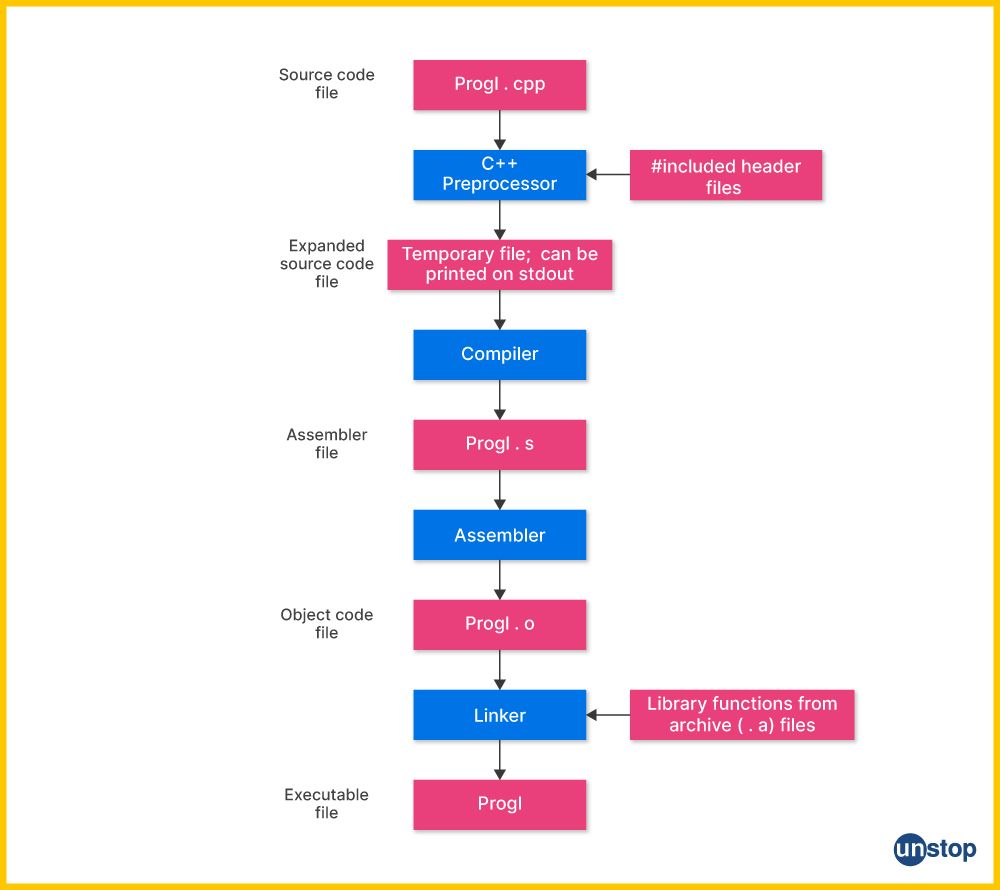
Understanding these steps provides insight into how C++ programs are transformed from source code into running applications. Each phase is integral to the development process, ensuring that code is correctly translated and executed.
Looking for guidance? Find the perfect mentor from select experienced coding & software experts here.
Explaining Structure Of C++ Program With Suitable Example
Understanding the structure of a C++ program is crucial for writing efficient and organized code. Below is a comprehensive example that incorporates various components discussed earlier.
Code Example:
/*
This is a sample program.
The purpose is to explain the structure of a C++ program.
We will make use of the various components we learned about in this article.
*/
#include // Include the input/output library
#include // Include the string library
using namespace std; // Use the standard namespace
// Defining a class
class Person {
public:
string name; // Data member
// Defining a member function
string printName() {
return name;
}
};
// Defining a function that adds two numbers and returns the sum
int sum(int a, int b) {
return a + b;
}
int main() {
// Declare and initialize various variables
int x = 5, y = 10;
float f = 3.14;
char c = 'a';
cout << "This is a Sample program for your understanding!!" << endl; // Output a message
// Using an if-else statement to find the larger number
if (x > y) {
cout << "x is greater than y!" << endl;
} else {
cout << "x is less than y!" << endl;
}
// Using a for loop to print the first 10 natural numbers
for (int i = 1; i <= 10; i++) {
cout << i << " ";
}
cout << endl;
cout << "x + y = " << sum(x, y) << endl; // Printing sum of x and y by calling sum function
Person p; // Creating an object of class Person
p.name = "MyName"; // Assign value to name using the object
cout << p.printName() << endl; // Print the assigned name using the object and member function
return 0;
}
LyoKVGhpcyBpcyBhIHNhbXBsZSBwcm9ncmFtLgpUaGUgcHVycG9zZSBpcyB0byBleHBsYWluIHRoZSBzdHJ1Y3R1cmUgb2YgYSBDKysgcHJvZ3JhbS4KV2Ugd2lsbCBtYWtlIHVzZSBvZiB0aGUgdmFyaW91cyBjb21wb25lbnRzIHdlIGxlYXJuZWQgYWJvdXQgaW4gdGhpcyBhcnRpY2xlLgoqLwojaW5jbHVkZSA8aW9zdHJlYW0+ICAvLyBJbmNsdWRlIHRoZSBpbnB1dC9vdXRwdXQgbGlicmFyeQojaW5jbHVkZSA8c3RyaW5nPiAgICAvLyBJbmNsdWRlIHRoZSBzdHJpbmcgbGlicmFyeQp1c2luZyBuYW1lc3BhY2Ugc3RkOyAvLyBVc2UgdGhlIHN0YW5kYXJkIG5hbWVzcGFjZQovLyBEZWZpbmluZyBhIGNsYXNzCmNsYXNzIFBlcnNvbiB7CnB1YmxpYzoKICAgIHN0cmluZyBuYW1lOyAvLyBEYXRhIG1lbWJlcgogICAgLy8gRGVmaW5pbmcgYSBtZW1iZXIgZnVuY3Rpb24KICAgIHN0cmluZyBwcmludE5hbWUoKSB7CiAgICAgICAgcmV0dXJuIG5hbWU7CiAgICB9Cn07Ci8vIERlZmluaW5nIGEgZnVuY3Rpb24gdGhhdCBhZGRzIHR3byBudW1iZXJzIGFuZCByZXR1cm5zIHRoZSBzdW0KaW50IHN1bShpbnQgYSwgaW50IGIpIHsKICAgIHJldHVybiBhICsgYjsKfQppbnQgbWFpbigpIHsKICAgIC8vIERlY2xhcmUgYW5kIGluaXRpYWxpemUgdmFyaW91cyB2YXJpYWJsZXMKICAgIGludCB4ID0gNSwgeSA9IDEwOwogICAgZmxvYXQgZiA9IDMuMTQ7CiAgICBjaGFyIGMgPSAnYSc7CiAgICBjb3V0IDw8ICJUaGlzIGlzIGEgU2FtcGxlIHByb2dyYW0gZm9yIHlvdXIgdW5kZXJzdGFuZGluZyEhIiA8PCBlbmRsOyAvLyBPdXRwdXQgYSBtZXNzYWdlCiAgICAvLyBVc2luZyBhbiBpZi1lbHNlIHN0YXRlbWVudCB0byBmaW5kIHRoZSBsYXJnZXIgbnVtYmVyCiAgICBpZiAoeCA+IHkpIHsKICAgICAgICBjb3V0IDw8ICJ4IGlzIGdyZWF0ZXIgdGhhbiB5ISIgPDwgZW5kbDsKICAgIH0gZWxzZSB7CiAgICAgICAgY291dCA8PCAieCBpcyBsZXNzIHRoYW4geSEiIDw8IGVuZGw7CiAgICB9CiAgICAvLyBVc2luZyBhIGZvciBsb29wIHRvIHByaW50IHRoZSBmaXJzdCAxMCBuYXR1cmFsIG51bWJlcnMKICAgIGZvciAoaW50IGkgPSAxOyBpIDw9IDEwOyBpKyspIHsKICAgICAgICBjb3V0IDw8IGkgPDwgIiAiOwogICAgfQogICAgY291dCA8PCBlbmRsOwogICAgY291dCA8PCAieCArIHkgPSAiIDw8IHN1bSh4LCB5KSA8PCBlbmRsOyAvLyBQcmludGluZyBzdW0gb2YgeCBhbmQgeSBieSBjYWxsaW5nIHN1bSBmdW5jdGlvbgogICAgUGVyc29uIHA7ICAgICAgICAgICAvLyBDcmVhdGluZyBhbiBvYmplY3Qgb2YgY2xhc3MgUGVyc29uCiAgICBwLm5hbWUgPSAiTXlOYW1lIjsgIC8vIEFzc2lnbiB2YWx1ZSB0byBuYW1lIHVzaW5nIHRoZSBvYmplY3QKICAgIGNvdXQgPDwgcC5wcmludE5hbWUoKSA8PCBlbmRsOyAvLyBQcmludCB0aGUgYXNzaWduZWQgbmFtZSB1c2luZyB0aGUgb2JqZWN0IGFuZCBtZW1iZXIgZnVuY3Rpb24KICAgIHJldHVybiAwOwp9Cg==
Output:
This is a Sample program for your understanding!!
x is less than y!
1 2 3 4 5 6 7 8 9 10
x + y = 15
MyName
Key Components Illustrated:
- Comments: Used to explain the purpose and functionality of code segments.
- Preprocessor Directives: #include statements to include necessary libraries.
- Namespace Declaration: using namespace std; to avoid prefixing standard library names with std::.
- Class Definition: class Person with a data member and a member function.
- Function Definition: int sum(int a, int b) to perform addition.
- Main Function: Entry point of the program where variables are declared and functions and class objects are utilized.
- Control Structures: if-else statement and for loop to control the flow of the program.
- Object Creation and Usage: Instantiating the Person class and accessing its members.
This example encapsulates the fundamental structure and components of a C++ program, providing a clear understanding for beginners and serving as a refresher for experienced programmers.
Conclusion
By now, you must agree with the statement that understanding the structure of C++ programs is essential for programmers aiming to write effective and efficient code. We have explained the structure of a CPP program clearly:
- It consists of a documentation section, followed by preprocessor directives, a namespace, and the main function. Each of these segments is crucial in the execution of a program.
- The main() further includes data types and variables, operators, control structures, comments, functions, classes, and objects, among other elements.
- Developers must also understand the various steps involved in the compilation and execution of a C++ program, from writing the code to execution.
Also Read: 51 C++ Interview Questions For Freshers & Experienced (With Answers)
Frequently Asked Questions
Q1. What are the main components of a C++ program?
The main components that make the structure of C++ program can be split into the following sections:
- Documentation Section: This section is used to document the logic, author details, purpose, and other relevant information about the program.
- Linking Section: Consists of preprocessor directives and inclusion for libraries and APIs.
- Preprocessor Directives: The #include and #define directives to include header files (like iostream header) and defining constants or macros, respectively.
- Namespace inclusion: For example, using namespace std; allows the program to utilize the standard library without prefixing identifiers with std::.
- Definition Section: This encompasses the definitions of classes, functions, global variables, typedefs, structures, unions, templates, and more.
- Main() Function: This is the entry point of the program and includes variable declarations, data types, operators, control statements, function calls, and a return statement, etc.
Each of these components is crucial in the successful execution of a program.
Q2. What is the role of the main() function in a C++ program?
The main function is the entry point for every C++ program. It’s where the program starts executing and is mandatory in every C++ program. It coordinates the program's flow by calling other functions, handling user input and output, and performing various tasks.
Q3. What are preprocessor directives in C++?
Preprocessor directives perform tasks such as including header files (#include), defining constants or macros (#define), and conditional compilation, all of which are processed before the actual compilation begins.
Q4. What are variables and data types in C++?
Variables are named locations used to store values/ data. C++ supports various data types such as integers, floating-point numbers, characters, and Boolean values. Each data type has a purpose and each data type has a different range and precision.
Q5. What are control structures in C++?
Control structures are statements used to control/ alter the flow of the program. They include if-else statements, switch statements, loops, while loops, and do-while loops.
Q6. What are functions in C++?
Functions are blocks of code, used to group a set of instructions to perform a specific task. Functions make the code reusable and modular.
Q7. What are classes and objects in C++?
Classes and Objects are major components of OOP paradigm in C++. Classes are user-defined data types containing data members and member functions that operate on the data members. Objects are instances of a class that allow access the data members and member functions.
Q8. What is the compilation process for a C++ program?
The compilation process involves preprocessing, compiling, assembly, and linking. Preprocessing executes directives, compilation converts code into machine-readable instructions, assembly turns machine code into object code, and linking connects the object code to necessary libraries to create the final executable file.
Q9. How is a C++ program executed by the computer?
After compilation, the operating system loads the executable file into memory and executes the program. The program interacts with the user and performs tasks until the main function ends, at which point it terminates and releases any resources used.
Test Your Skills: Quiz Time
By now, you must clearly understand the structure of C++ programs. You might also be interested in reading the following:
- Pointers in C++ | A Roadmap To All Pointer Types (With Examples)
- New Operator In C++ | Syntax, Working, Uses & More (+Examples)
- What Are Storage Classes In C++? A Detailed Guide With Examples
- Array In C++ | Define, Types, Access & More (Detailed Examples)
- References In C++ | Declare, Types, Properties & More (+Examples)
An economics graduate with a passion for storytelling, I thrive on crafting content that blends creativity with technical insight. At Unstop, I create in-depth, SEO-driven content that simplifies complex tech topics and covers a wide array of subjects, all designed to inform, engage, and inspire our readers. My goal is to empower others to truly #BeUnstoppable through content that resonates. When I’m not writing, you’ll find me immersed in art, food, or lost in a good book—constantly drawing inspiration from the world around me.
Login to continue reading
And access exclusive content, personalized recommendations, and career-boosting opportunities.
Subscribe
to our newsletter












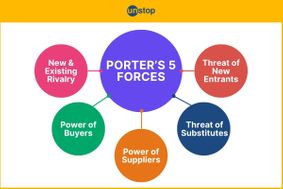


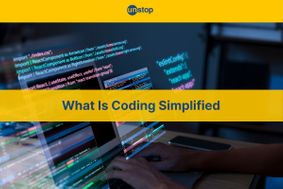
Comments
Add comment